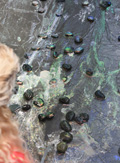
A stream of sparkling colors changed hues as it shimmered down a rocky pathway accompanied by the oohs and aahs of Texas A&M College of Architecture students and faculty gathered around the temporary oasis, constructed Jan. 30 on the Langford Architecture Center bridge.
The faux babbling brook was created by second-year environmental design student Kristin Curtiss, as part of an independent study with visiting assistant professor of architecture Jill Mulholland.
Curtiss’ idea for the project arose from studying contemporary materials, including Helicone HC, microscopic platelets reflecting colors that change with the angle of view. The material, she thought, could have architectural applications.
“Maybe we could transform this to an architectural material or panel,” she said. “As the sun moved over a building you’d get a different perception of the building depending on what time of day it was and whether it was sunny or cloudy.”
Passersby, intrigued by Curtiss’ installation, picked up containers of the plain-looking, tan-colored, powdery substance and help her pour it into the flowing water.
When the powder was shaken onto the stream, it blossomed into a multicolored display that reflected a variety of metallic-looking hues as it traveled from shade to sun and farther away from viewers. Powders in different containers gave off even more hues.
“The rocks,” she said, “are a mechanism to disperse the streams of water to see if you could get colors separating and then re-merging.”
At the bottom of the display, rocks were arranged to allow the shimmering platelets to pool, which Curtiss said was to create a panel-like effect.
More information on Helicone HC is at http://www.helicone.com



